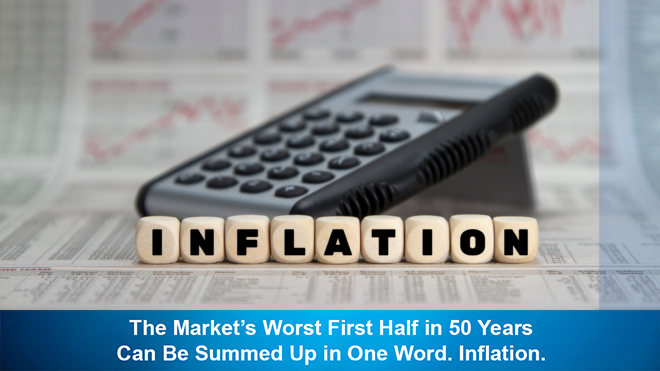A multitude of factors conspired to generate the stock market’s worst first-half since 1970, all centering on inflation.
The cost of living is up, the cost of housing is up, the cost of food is up, the cost of energy is up, the cost of healthcare is up and even higher education has become unaffordable for many families.

The carnage has been widespread.
- The stock market has been brutalized, with the Dow Jones Industrial Average down nearly 6 percent for the year through Friday and more than 20 percent from its record high set in January.
- Bonds have also been beaten down, with the yield on 10-year Treasuries exceeding 3 percent for the first time since 2011 and tumbling to a five-month low of 2.82 percent on Friday.
- Real estate values are slumping at their fastest pace in six years, according to data from Trulia Inc., amid rising mortgage rates and fears about how far house prices may fall when it’s time for buyers to refinance or sell their homes.
- Commodities markets have suffered big losses as investors fret about slower growth around the world—especially China—and declining demand from major economies like Germany and Japan.


Uncertainty about the path ahead has compounded the nettlesome impact of inflation running by one Labor Department measure at 8.6%, the highest since December 1981. As recently as December 2021, the Fed, which targets inflation at 2%, was projecting its preferred headline measure to run at 2.6% this year; new data Thursday showed it at 6.3%, with core inflation excluding food and energy even running at 4.7%.
The market is cyclical: It goes up and down, sometimes wildly so. When stocks drop, everyone panics—investors flee the market in droves and pull their money out of their investments before they lose any more value (what we call “selling at the bottom”). But remember that while the stock market can be unpredictable, it’s also very cyclical; after every dip comes an inevitable rebound as investors rush back in. In fact, this pattern has been repeated throughout history: During bear markets (when prices go down), there are significant drops followed by significant recoveries—and vice versa during bull markets (when prices go up).


The cost of living started the year running at levels the U.S. had not seen since the early 1980s, according to data released last week by the Bureau of Labor Statistics (BLS). The consumer price index (CPI) rose 0.9% in April from March and 2% from a year earlier, both beating expectations for a 0.7% print on each count.
The BLS noted that core inflation—which excludes food and energy costs—increased at an annualized rate of 2% in April, up from an already-elevated 1.7% rate recorded in March. Even more troubling is that core CPI has now risen above 3% for seven straight months through April, marking the longest streak since late 2008 when oil prices were still recovering after falling sharply during the financial crisis and credit markets were tightening rapidly due to systemic risk concerns at large investment banks like Lehman Brothers Inc., which ultimately failed within days of posting record losses during Q3 2008 alone.”


Inflation impacts how much a retiree can withdraw from their portfolio and their lifestyle during retirement. A MetLife poll found that 4,416 U.S. adults were maintaining and increasing contributions to their retirement savings. While this is a good thing in the long term, it’s not the best move in the short term. Since more people were increasing contributions to their retirement, this left them short handed on accounts like emergency savings.
The best way to protect yourself from inflation is by creating a financial plan. When creating your financial strategy it’s important to note there will be changes made to it in the future. This is not something that should be thought of once and then forgotten when you retire. Changing market environments can sometimes mean making difficult choices, so using an advisor you trust who knows the markets and your retirement goals is a must.
For more inflation protection strategies, check out our recent blog here.

To summarize, there simply hasn’t been enough serious conversation within the financial planning community regarding changing inflation expectations. Don’t get caught by surprise or complacency when seriously considering an upcoming retirement goal.
When facing such extreme inflation rates, it can be difficult to gather all of these assets together into a balanced portfolio that will provide enough income to last the entire length of an individual’s retirement. Fortunately, the financial advisors at CKS Summit Group can help!
We offer professional services in several areas of financial planning such as: retirement income planning, wealth management, tax efficient strategies, asset protection, legacy planning, and IRA & 401K rollovers.

